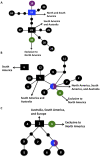Emergence and pathogenicity of highly virulent Cryptococcus gattii genotypes in the northwest United States
- PMID: 20421942
- PMCID: PMC2858702
- DOI: 10.1371/journal.ppat.1000850
Emergence and pathogenicity of highly virulent Cryptococcus gattii genotypes in the northwest United States
Abstract
Cryptococcus gattii causes life-threatening disease in otherwise healthy hosts and to a lesser extent in immunocompromised hosts. The highest incidence for this disease is on Vancouver Island, Canada, where an outbreak is expanding into neighboring regions including mainland British Columbia and the United States. This outbreak is caused predominantly by C. gattii molecular type VGII, specifically VGIIa/major. In addition, a novel genotype, VGIIc, has emerged in Oregon and is now a major source of illness in the region. Through molecular epidemiology and population analysis of MLST and VNTR markers, we show that the VGIIc group is clonal and hypothesize it arose recently. The VGIIa/IIc outbreak lineages are sexually fertile and studies support ongoing recombination in the global VGII population. This illustrates two hallmarks of emerging outbreaks: high clonality and the emergence of novel genotypes via recombination. In macrophage and murine infections, the novel VGIIc genotype and VGIIa/major isolates from the United States are highly virulent compared to similar non-outbreak VGIIa/major-related isolates. Combined MLST-VNTR analysis distinguishes clonal expansion of the VGIIa/major outbreak genotype from related but distinguishable less-virulent genotypes isolated from other geographic regions. Our evidence documents emerging hypervirulent genotypes in the United States that may expand further and provides insight into the possible molecular and geographic origins of the outbreak.
Conflict of interest statement
The authors have declared that no competing interests exist.
Figures








References
Publication types
MeSH terms
Grants and funding
LinkOut - more resources
Full Text Sources
Other Literature Sources

